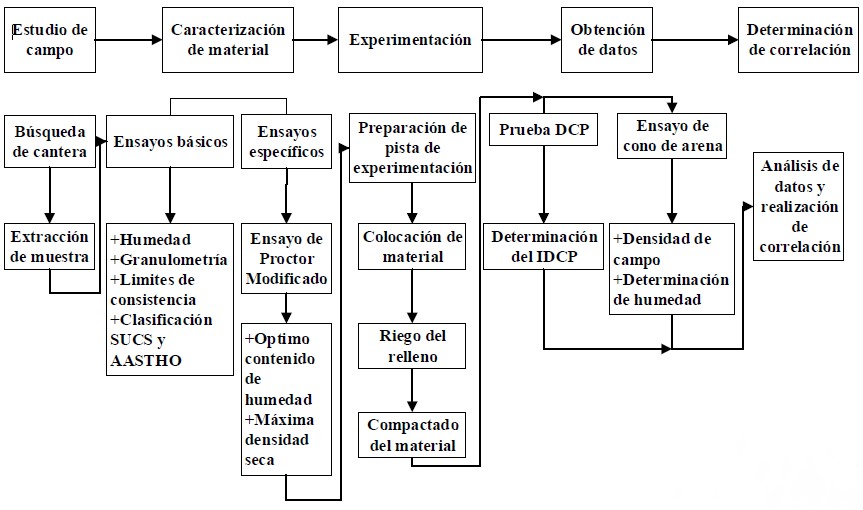Estimation of the dry density of a granular backfill using the dynamic cone penetrometer
DOI:
https://doi.org/10.51372/gacetatecnica242.6Keywords:
granular backfill, dynamic cone penetrometer, dry densityAbstract
The quality control of a fill is generally performed with standardized methods, such as the sand cone and the nuclear densimeter, but an alternative method, the dynamic cone penetrometer, is being proposed and is usually used to calculate the in situ California bearing ratio. In this investigation, the dynamic cone penetrometer was used to perform quality control of a silty clayey gravel soil with sand. First, the material was characterized, basic and specific tests were carried out, and a 12,00m long test fill was made, divided into seven zones, compacted with different energies, and sand cone and dynamic cone penetrometer tests were carried out. With the data obtained, a correlation equation was determined, where the dynamic cone penetrometer index was the independent variable and the dry density the dependent variable. With the equation we proceeded to calculate the dry density of a compacted platform with a single test energy of 2,40x2,40m, a good correlation was estimated between the compacted dry density and the dynamic cone penetrometer index, thus showing the possibility of its use in the quality control of a granular backfill. In the comparison of the dry density calculated from the correlation equation and the density found with the sand cone, it was observed that it varies around 6%
Downloads
References
H. Chennarapu, T. K. Garala, R. Chennareddy, U. Balunaini, y G. Venkata Narasimha Reddy, “Compaction Quality Control of Earth Fills Using Dynamic Cone Penetrometer,” J. Constr. Eng. Manag., vol. 144, no. 9, pp. 1–10, 2018
E. Ganju, H. Kim, M. Prezzi, R. Salgado, y N. Z. Siddiki, “Quality assurance and quality control of subgrade compaction using the dynamic cone penetrometer,” Int. J. Pavement Eng., vol. 19, no. 11, pp. 966–975, 2016
L. D. Wesley, “Soil Compaction,” in Fundamentals of Soil Mechanics for Sedimentary and Residual Soils, Hoboken, NJ, USA: John Wiley & Sons, Inc., 2009, pp. 391–404
Y. Gansonré, P. Breul, C. Bacconnet, M. Benz, y R. Gourvès, “Prediction of in-situ dry unit weight considering chamber boundary effects on lateritic soils using Panda® penetrometer,” Int. J. Geotech. Eng., vol. 16, no. 4, pp. 408–414, 2022
R. B. Freeman, C. A. Gartrell, L. D. Wakeley, E. S. Berney, y J. R. Kelley, “Steel-shot method for measuring the density of soils,” Can. Geotech. J., vol. 47, no. 11, pp. 1299–1304, 2010
A. M. Hamid, O. S. B. Al-Amoudi, y S. A. Aiban, “Assessing the Effect of Density and Water Level on the Degree of Compaction of Sand Using Dynamic Cone Penetration Test,” Arab. J. Sci. Eng., vol. 44, no. 5, pp. 4921–4930, 2018
H. Kim, “Dynamic analysis of dynamic cone penetration test for subgrade compaction assessment,” Purdue University, 2014
B. Yang, R. Zhang, X. Zha, C. Liu, y Q. Pan, “Improved testing method of dynamic cone penetrometer in laboratory for evaluating compaction properties of soil subgrade,” Road Mater. Pavement Des., vol. 17, no. 2, pp. 487–498, 2015
C. Lee, K. Kim, W. Woo, y W. Lee, “Soil Stiffness Gauge ( SSG ) and Dynamic Cone Penetrometer ( DCP ) tests for estimating engineering properties of weathered sandy soils in Korea,” Eng. Geol., vol. 169, pp. 91–99, 2014
F. S. Tehrani, C. L. Meehan, y F. Vahedifard, “Comparison of Density-Based and Modulus-Based In Situ Tests for Earthwork Quality Control,” pp. 2345–2354, 2014
A. Mohajerani et al., “A practical technique for the compaction control of sand in road construction: using a dynamic lightweight cone penetrometer,” Road Mater. Pavement Des., vol. 22, no. 1, pp. 200–214, 2019
Q. A. Tran, B. Chevalier, y P. Breul, “Spectral Analysis of the Response of Coarse Granular Material to Dynamic Penetration Test Modelled with DEM,” Int. J. Geosynth. Gr. Eng., vol. 4, no. 3, pp. 1–10, 2018
J. C. Quezada, P. Breul, G. Saussine, y F. Radjai, “Penetration test in coarse granular material using Contact Dynamics Method,” Comput. Geotech., vol. 55, pp. 248–253, 2014
A. S. I. Kofi y F. G. J. Yao, “The influence of water content on the Dynamic Cone Penetration Index of a lateritic soil stabilized with various percentages of a quarry by-product,” Transp. Geotech., vol. 5, pp. 68–85, 2015
T. B. Edil y C. H. Benson, “Investigation of DCP and SSG as alternative methods to determine subgrade stability,” University of Wisconsin-Madison, 2005
P. W. Jayawickrama, A. L. Amarasiri, y P. E. Regino, “Use of dynamic cone penetrometer to control compaction of granular fill,” Transp. Res. Rec., no. 1736, pp. 71–80, 2000
M. A. Y. Montes, “Determinación de la ecuación de correlación entre el PDC Y CBR con muestra inalterada, en suelos a nivel de subrasante en el tramo Gallito de las Rocas-Los Olivos, región Junín,” Universidad Peruana Unión, 2020
J. S. Lee, S. Y. Kim, W. T. Hong, y Y. H. Byun, “Assessing subgrade strength using an instrumented dynamic cone penetrometer,” Soils Found., vol. 59, no. 4, pp. 930–941, 2019

Published
How to Cite
Issue
Section
Copyright (c) 2023 Iván José Guevara Lopez, Ferrer Canaza Rojas

This work is licensed under a Creative Commons Attribution-NonCommercial-ShareAlike 4.0 International License.
The opinions expressed by the authors do not necessarily reflect the position of the editor of the publication or UCLA. The total or partial reproduction of the texts published here is authorized, provided that the complete source and electronic address of this journal is cited. Authors have the right to use their articles for any purpose as long as it is done nonprofit. The authors can post on the internet or any other media the final approved version of their work.






.png)




